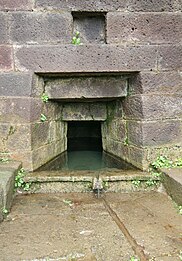Su Tempiesu
Su Tempiesu is the best preserved fountain sanctuary ( Italian Pozzo sacro ) in Sardinia and one of the few well-preserved examples of architecture from the Nuragic period. It is located east of Orune in the Nuoro Province on a steep slope in a remote valley.
The small temple was built by the Nuragic culture for the water cult and was built in the late period. Thanks to a landslide that covered it until 1953 (the year it was discovered), it was largely preserved in its above-ground part.
The front of the temple was about 3.5 m high. A two-meter-high, trapezoidal niche with a floor space of just four square meters lies in a house-like element with a steep roof. At the far end, a narrowing, unusually low opening leads over steps to the round water outlet. The rear area is separated from the niche by a threshold into which an overflow channel is incorporated. The water that collected in the rear area flowed (when the water level was high) through a channel to the outside. The niche represents the center of the temple. Here the offerings were placed on two side bench altars . In front of the cult niche there is a small forecourt, which is walled in waist-high and raised by four steps. This outer area is bordered by another low oval wall. Well temples have a complicated shape than nuraghi . Its stones are of the same type as the nuraghi, but they are very precisely worked.
- Su Tempiesu
See also
literature
- Jürgen E. Walkowitz: The megalithic syndrome. European cult sites of the Stone Age (= contributions to the prehistory and early history of Central Europe. Vol. 36). Beier & Beran, Langenweißbach 2003, ISBN 3-930036-70-3 .
- Maria Ausilia Fadda: Su Tempiesu by Orune. Fonte sacra Nuragica . Il Torchietto, Ozieri 1992, ( Soprintendenza Archeologica per le Province di Sassari e Nuoro Quaderni 18).
Web links
- Website of the supervising cooperative LARCo. with explanations and photos
- ital.
- Location map of Su Tempiesu (B + C)
Coordinates: 40 ° 24 ′ 39.43 " N , 9 ° 24 ′ 46.32" E




